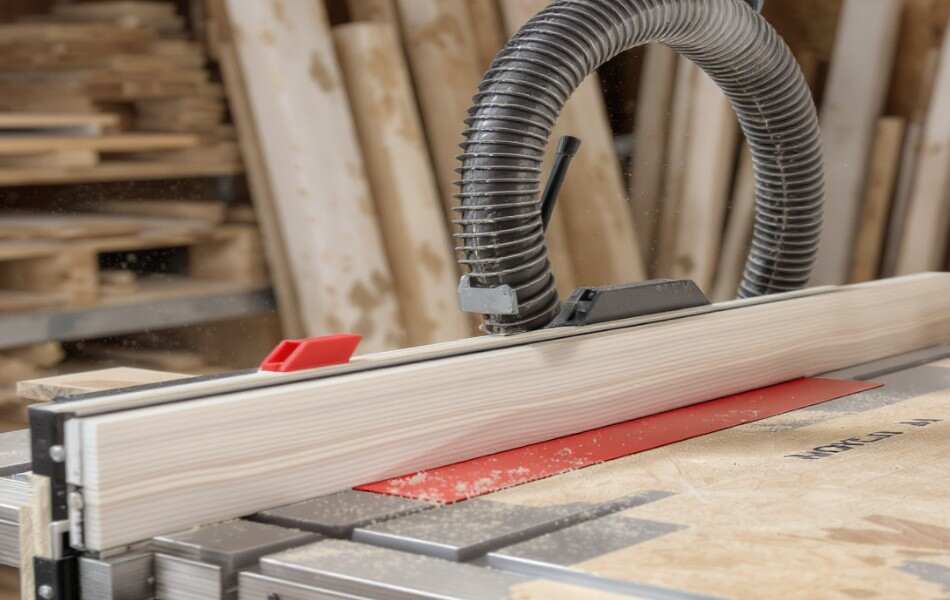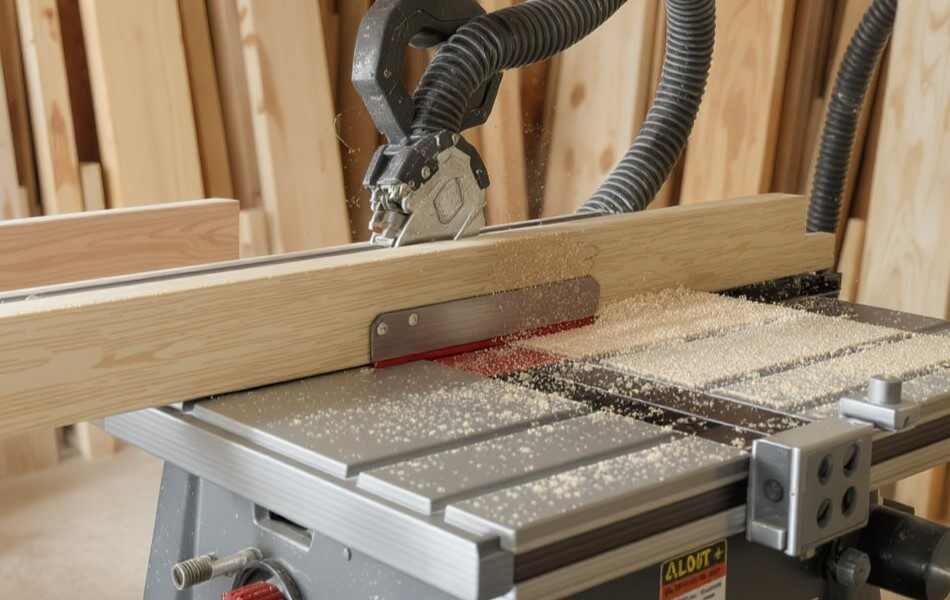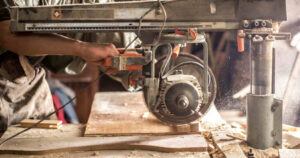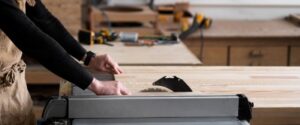Why Learn to Use a Table Saw?
Have you ever seen a perfectly straight cut in wood and wondered how it was made? Most likely, a table saw was involved. This powerful tool lets you cut quickly, accurately, and confidently. You can make rip cuts along the grain, cross cuts across the grain, and even angled bevel cuts.
But a table saw can be dangerous if used incorrectly. One common hazard is kickback, when the wood is suddenly thrown back toward you. That’s why learning how to operate a table saw safely is crucial for beginners.
In this guide, you’ll learn about the main parts of a table saw, essential safety rules, step-by-step cutting instructions, common beginner mistakes, and maintenance tips. By the end, you’ll feel confident making precise cuts while staying safe.
Table of Contents
Safety Gear and Preparation
Safety should always come first. By setting up your protective gear and organizing your workspace carefully, you can avoid most accidents before the saw is even on. Always check that the blade is sharp and properly installed, as a dull or misaligned blade is a major cause of accidents.
Essential Safety Gear
- Safety Glasses or Goggles: Protect your eyes from flying sawdust and wood chips. Even a small splinter can cause lasting damage.
- Hearing Protection: Table saws are loud. Use earplugs or earmuffs to protect your hearing.
- Dust Mask or Respirator: Cutting plywood or MDF produces fine dust that can harm your lungs. Wear a respirator to stay safe.
- Gloves (Optional): Only when handling raw wood; never while cutting.
- Push Sticks and Push Blocks: These tools help guide narrow pieces safely past the blade while keeping your hands away.
Blade and Saw Checks
- Blade Height: Set the blade so it sticks about ¼ inch above the material.
- Blade Rotation Check: With the saw unplugged, spin the blade by hand to ensure it turns smoothly.
- Emergency Stop: Know where the power switch is to quickly turn off the saw if needed.
Workspace Preparation
- Keep the floor clear of scraps and cords to prevent tripping.
- Ensure the area is well-lit so no shadows hide the blade.
- Position the saw on a stable surface and connect it to a dust collector if possible.
- Keep a fire extinguisher nearby, as fine wood dust can ignite.
Table Alignment: Check that the rip fence is parallel to the blade and that the miter gauge sits correctly in its slot. Misalignment increases the risk of kickback.
Offcut Awareness: Allow scraps to fall naturally. Never reach over a spinning blade.
Getting to Know Your Table Saw: Parts and Functions

Knowing the parts of a table saw is critical for beginners. Understanding each component helps you operate the saw safely, make accurate cuts, and avoid common mistakes. Here’s a detailed guide to the essential parts of a table saw:
Tabletop
The tabletop is the flat surface where your workpiece rests. It provides stability and allows wood to slide smoothly during cuts.
Keep the tabletop clean and free from sawdust for precise cutting and smoother wood movement.
Rip Fence
The rip fence is a straight guide that runs parallel to the blade, helping you make straight rip cuts along the grain. Always lock it securely before starting a cut.
Double-check the alignment with a measuring tape to prevent binding or uneven cuts.
Miter Gauge
The miter gauge slides in a slot on the tabletop and is used for angled or crosscuts. It ensures precision when cutting across the grain or making angled cuts.
Always hold the wood firmly against the miter gauge for a straight, clean cut.
Blade
Table saws use different blades depending on the type of cut:
- Rip Blades: Best for cutting along the grain.
- Crosscut Blades: Designed for cuts across the grain.
- Combination Blades: Suitable for both rip and crosscuts.
- Specialty Blades: For dado cuts, laminates, or non-wood materials.
Using the correct blade reduces burn marks, tear-out, and kickback risk.
Throat Plate
The throat plate surrounds the blade and prevents small wood scraps from falling into the motor housing.
Replace damaged or worn throat plates to maintain safety and accuracy.
Riving Knife / Splitter
This part sits behind the blade to prevent the wood from pinching the blade, which can cause kickback.
Always keep the riving knife aligned with the blade. Never remove it when making standard cuts.
Blade Guard
The blade guard is a clear shield that protects your fingers from accidental contact with the spinning blade.
Keep the guard in place during every cut, especially if you’re a beginner.
Dust Port
The dust port connects to a shop vacuum or dust collector to minimize airborne dust and keep your workspace clean.
Connect a vacuum to reduce health risks from fine dust and keep visibility clear.
Controls
Controls include the on/off switch and the emergency stop button. Knowing their locations is essential for safety.
Familiarize yourself with the emergency stop before using the saw.
Rip Capacity
Rip capacity indicates the maximum width the saw can cut safely. Exceeding this can strain the motor or cause kickback.
Always check your saw’s manual and avoid forcing oversized wood through the blade.
Quick Tip for Beginners: Spend a few minutes identifying each part of your table saw before starting. Understanding the function and safety importance of each component will make your cutting safer and more accurate.
Step-by-Step: How to Use a Table Saw
Using a table saw is simple if you follow each step carefully. Here’s a beginner-friendly guide:
Set the Blade Height
Adjust the blade so the teeth stick about 1/8 to 1/4 inch above the wood.
- Too high is dangerous.
- Too low may burn or tear the wood.
Align the Fence
For rip cuts (cutting along the grain), make sure the fence is parallel to the blade.
Double-check alignment with a measuring tape before starting.
Position the Wood
Place the wood flat on the table.
Keep the edge pressed firmly against the fence to prevent it from wandering.
Stand in the Right Position
Never stand directly behind the blade. Stand slightly to one side. This reduces the risk of injury in the event of kickback.
Make the Cut
Turn on the saw and wait until the blade reaches full speed.
- Hold the wood steady against the fence.
- Feed the wood slowly and evenly.
- Use push sticks for narrow pieces.
- Do not stop midway—finish the cut before turning off the saw.
If you’re looking for a reliable option to start with, you can read my in-depth review of the DeWalt DWE7491RS Table Saw
Handle Different Cuts
- Rip Cuts: Along the grain, using the fence.
- Crosscuts: Across the grain, using the miter gauge.
- Bevel Cuts: Tilt the blade for angled cuts.
- Dado Cuts: Use a dado blade to cut grooves for joints.
Beginner-Friendly Projects
Starting with simple projects is the best way to build confidence on a table saw. Here are some ideas:
- Cutting boards for shelves: Measure and rip cut lumber, then crosscut to size for small storage or book shelves.
- Trimming lumber for furniture frames: Use the rip fence to size boards evenly for tables, chairs, or cabinets.
- Creating picture frames: Make precise 45° crosscuts with the miter gauge for perfect corners.
- Building small storage boxes: Practice rip cuts and dados to create joints for simple boxes.
- Making jigs and featherboards: Once comfortable, try creating tools that improve accuracy and safety.
Avoiding Kickback
Kickback is one of the most dangerous accidents when using a table saw. It happens when the blade catches the wood and forcefully throws it back toward the operator.
Preventing this requires both proper setup and correct technique. Always keep the riving knife or splitter properly aligned, as it stops the cut pieces from closing in on the blade.
A sharp blade is also critical because dull teeth increase the chance of grabbing and lifting the workpiece. The rip fence should remain parallel to the blade so the wood does not bind as it moves through the cut.
Before cutting, check that your lumber is straight and free from warps, twists, or hidden knots. Using featherboards or hold-downs helps keep the wood pressed firmly against the fence, reducing shifting.
Finally, never stand directly behind the board while feeding it through the blade. Shifting slightly to one side ensures that even if kickback occurs, you are out of its direct path.
By combining proper alignment, sharp blades, and smart positioning, you can cut with confidence while minimizing this serious hazard.
Common Beginner Mistakes
Beginners often make errors that can harm both the project and the user. Avoid these pitfalls:
- Removing Blade Guards – These guards protect you and should only be removed when absolutely necessary.
- Freehand Cutting – Always use a fence or miter gauge; freehand cuts are unsafe.
- Wrong Blade Choice – Rip blades for with-the-grain cuts, crosscut blades for across-the-grain.
- Cutting Small Pieces Without Jigs – Always use sleds or push blocks for tiny pieces.
- Feeding Too Fast – Pushing wood too quickly can burn it and strain the motor.
- Cutting Warped or Dirty Lumber – Nails, knots, or twists can damage the blade and cause accidents.
Common problem-solving
Even with proper setup, beginners often face common issues while using a table saw. Knowing the cause and solution will help you fix problems quickly and keep your cuts precise.
Burned Wood
- Cause: Usually caused by a dull blade, misaligned fence, or feeding wood too slowly.
- Solution: Sharpen or replace the blade, check fence alignment, and maintain a steady feed rate. Avoid pausing mid-cut.
Blade Wander (Crooked Cuts)
- Cause: Fence misalignment, warped wood, or using the wrong blade for the cut.
- Solution: Realign the rip fence parallel to the blade, use straight and clean lumber, and ensure the correct blade is installed.
Kickback
- Cause: Misaligned riving knife, dull blade, forcing wood through too fast, or cutting without proper support.
- Solution: Always use the riving knife or splitter, keep blades sharp, feed wood smoothly, and stand slightly to the side of the blade.
Excessive Vibration or Noise
- Cause: Loose parts, misaligned blade, unbalanced blade, or an uneven table surface.
- Solution: Tighten all bolts and fasteners, check blade balance, realign the blade, and place the saw on a stable, level surface.
Maintenance Tips for Long Life
A table saw is an investment, and regular maintenance keeps it safe, accurate, and long-lasting.
After every session, brush away sawdust and wipe down the tabletop to prevent rust. Blades should also be checked frequently; a sharp blade not only produces cleaner cuts but also reduces strain on the motor.
Once a month, lubricate the height and tilt mechanisms so they move smoothly. At the same time, inspect the fence and miter gauge with a square to ensure they remain accurate.
The power cord should be checked for signs of wear or cracking, as damaged wiring poses a fire hazard. For long-term reliability, clean the dust collection system and motor housing at least once a year, especially if you use the saw heavily.
Replacing worn throat plates, riving knives, or blade guards is also essential because these safety parts directly affect both performance and protection.
With a consistent care routine—daily cleaning, monthly alignment, and yearly deep checks—you extend the life of your table saw and ensure every cut stays precise.
FAQ
What is the safest way to use a table saw?
Always wear safety gear, use a riving knife, keep the guard in place, and use push sticks for small pieces.
Can a beginner use a table saw?
Yes, but beginners must follow safety rules strictly and practice on scrap wood before moving to real projects.
Can a table saw cut materials other than wood?
Yes, with the correct blade. You can cut plastic, laminate, and even some metals, but only with the right setup and precautions.
Conclusion
A table saw is one of the most versatile and valuable tools in woodworking. With proper knowledge, safety practices, and maintenance, beginners can make accurate, repeatable cuts safely.
Always remember: safety first, precision second, and controlled work pace third.
Whether building furniture, crafting DIY home projects, or trimming lumber, mastering a table saw is a skill that will benefit you for years. Regular practice, proper setup, and careful attention to safety will allow you to unlock the full potential of your table saw and complete projects confidently.

Welcome to Homenias, I’m Jaman M, and I’m here to help you discover the best home products. With years of experience, they offer genuine reviews and helpful guides. Their mission is to make your choices easier. It’s organizing your space or finding creative solutions. Explore how the right products can enhance your everyday life. Don’t miss out on finding the best home products to raise your living experience.





